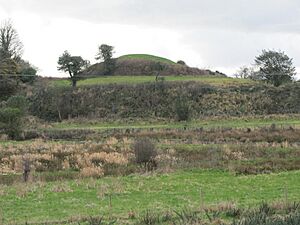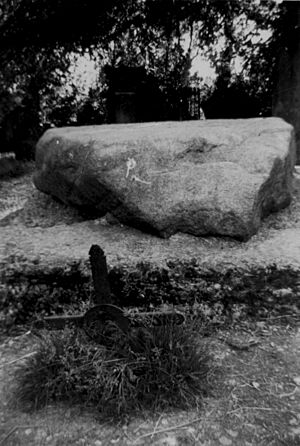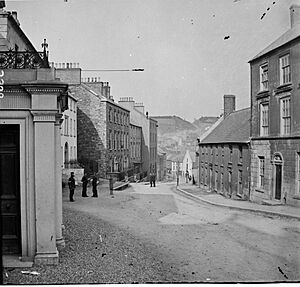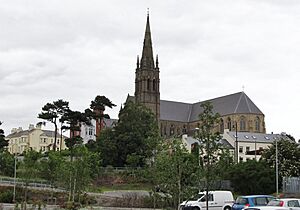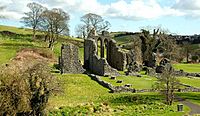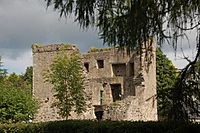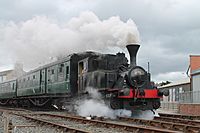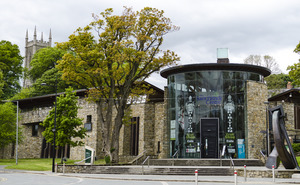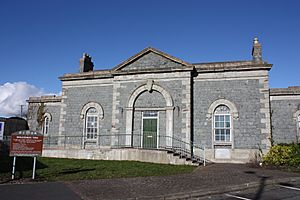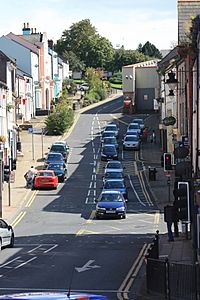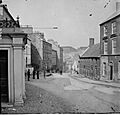Downpatrick facts for kids
Quick facts for kids Downpatrick
|
|
|---|---|
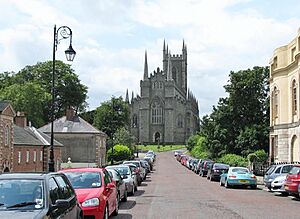 Down Cathedral |
|
| Population | 11,545 (2021 Census) |
| District |
|
| County | |
| Country | Northern Ireland |
| Sovereign state | United Kingdom |
| Post town | DOWNPATRICK |
| Postcode district | BT30 |
| Dialling code | 028 |
| Police | Northern Ireland |
| Fire | Northern Ireland |
| Ambulance | Northern Ireland |
| EU Parliament | Northern Ireland |
| UK Parliament |
|
| NI Assembly |
|
Downpatrick is a historic town in County Down, Northern Ireland. Its name, Dún Pádraig, means "Patrick's fort" in Irish. The town is located on the Lecale peninsula, about 21 mi (34 km) south of Belfast.
In the Middle Ages, Downpatrick was a very important place. It was the capital of the Dál Fiatach, a powerful ruling family in Ulaid (Ulster). Its cathedral is famous because it is believed to be the burial place of Saint Patrick, Ireland's patron saint. Today, Downpatrick is the main town of County Down. It is also one of the headquarters for the Newry, Mourne and Down District Council. In 2021, about 11,545 people lived in Downpatrick.
Contents
Discovering Downpatrick's Past
Ancient Times
People have lived in the Downpatrick area for a very long time. Archaeologists found two ancient roundhouses from the Bronze Age (a time when people used bronze tools) in the Meadowlands area. One roundhouse was four metres wide, and the other was over seven metres wide.
Later digs on Cathedral Hill found signs of a much older fort. This fort was built around an early Christian monastery.
Early History of the Town
Downpatrick is one of the oldest towns in all of Ireland. Its name comes from a dún, which means a fort or stronghold. This fort stood on a hill called a drumlin, overlooking the River Quoile. Long ago, the river was like a wide bay, surrounding the hill on most sides.
People believe there was a ringfort (a circular fort with earthen walls) here in the early Middle Ages. This might have been the famous Ráth Celtchair, named after a hero from old Irish stories.
A small Christian monastic settlement (a community of monks) was also built on a nearby hill, now called 'Cathedral Hill'. The nearby Saul Monastery is linked to Saint Patrick. It is said that Saint Patrick was buried on Cathedral Hill in the 400s. His grave is still a special place for people to visit. Down Cathedral was later built on this very spot.
Around the 1000s, a much larger fort was built on the northern hill, now called the 'Mound of Down'. This became the main base for the Dál Fiatach kings, who ruled Ulster.
In 1102, Magnus Barefoot, the King of Norway, was killed in a fight near Downpatrick. His grave is thought to be marked by a mound at Horse Island.
Saint Malachy became the Bishop of Down in 1137. He helped repair and make Down Cathedral bigger.
Norman Arrival and Changes
In the late 1100s, Anglo-Norman knights, led by John de Courcy, took over the area. In 1177, a Norman army marched from Dublin and captured Downpatrick. The local Irish king tried to get the town back but failed. The Normans started building a motte (a type of castle on a mound) inside the old fort. However, de Courcy later moved his main base to Carrickfergus.
In 1183, de Courcy brought Benedictine monks to Downpatrick. He built a friary (a monastery for friars) for them. This building was later destroyed by an earthquake in 1245. He also renamed the cathedral to Saint Patrick's.
It is said that de Courcy found the bones of Saint Patrick, Saint Brigid, and Saint Colmcille in Downpatrick. These important relics were reburied inside the cathedral in 1196. Many believe de Courcy made up this story for political reasons.
The town's name changed over time. In old Latin and English papers, it was called 'Dunum' or 'Dun'. The name 'Downpatrick' first appeared in the early 1600s.
In 1260, Brian O'Neill, a powerful Irish king, marched to Downpatrick. He fought the Anglo-Normans in the Battle of Down. O'Neill was killed, and the Irish were defeated.
Later History and Changes
Around 1540, King Henry VIII of England ordered that monasteries be closed. Downpatrick's monastery was shut down, and the Cathedral became a ruin. In 1600, English forces reportedly burned the cathedral. An old painting from 1788 shows the ruined abbey and its round tower.
In the 1700s, the town improved a lot thanks to the Southwell family. Edward Southwell built a market area in 1719 and paved the streets. He also built a quay (a dock) and a grain store, which helped the town's economy grow. Another Edward Southwell built Southwell School in 1733.
The first hospital in Downpatrick opened in 1767. It moved to a former army barracks in 1774. This building was used as a hospital until a new one, the Downe Hospital, opened in 1834.
In 1778, John Wesley, who started Methodism, preached in Downpatrick. He called the ruined Down Cathedral a "noble ruin."
1800s and Beyond
On October 21, 1803, Thomas Russell, a leader of the United Irishmen, was executed outside Downpatrick Gaol. He was trying to support a rebellion led by Robert Emmet. Russell is buried in the graveyard of St Margaret's Church. His friend, Mary Ann McCracken, paid for his grave.
In 1829, Daniel O'Connell, a famous lawyer and campaigner for Catholic rights, visited Downpatrick. He was there for a court case. He also attended a dinner in his honour with many local gentlemen.
On St Patrick's Day in 1848, a large group of Catholics tried to parade to Saint Patrick's grave. They were attacked by Protestants, and a riot broke out.
The Troubles in Downpatrick
During a period known as the Troubles, Downpatrick saw many attacks. One of the most serious events was the Downpatrick landmine attack in 1990. The Provisional Irish Republican Army (IRA) set off a large bomb under a British Army convoy. Four soldiers were killed in this attack.
Places to Explore in Downpatrick

- Ballyalton Court Cairn is an ancient burial site. It is a single court grave located near Ballyalton village, about 0.5 miles (0.80 km) from the village and 2.25 miles (3.62 km) east of Downpatrick.
- Ballynoe stone circle is a large circle made of over 50 stones. It surrounds a mound where cremated bones were found. It is about 2.5 miles (4 km) south of Downpatrick.
- The Down Arts Centre is a place for events in the town. It used to be the Downpatrick Town Hall.
- Down County Museum is located in the old Down County Gaol (jail). This building was built between 1789 and 1796. It is famous because Thomas Russell was executed at its gates in 1803.
- Downpatrick Racecourse is where horse racing takes place. Horse races have been held here since the time of King James II of England.
- Downpatrick and County Down Railway is Ireland's only full-sized heritage railway. It runs on the old railway line to Belfast. You can ride it to Inch Abbey and other historic spots. The railway has Ireland's largest collection of old Victorian train carriages.
- Inch Abbey is a large, ruined Cistercian monastery. It has beautiful early Gothic architecture. It is about 0.75 miles (1.2 km) north-west of Downpatrick, by the River Quoile.
- The Lecale peninsula is a large area of about 78 square miles (200 km2) between Downpatrick and Dundrum. It is important for its history and geography.
- The Mound of Down or Rathkeltair is a major ancient earthwork. It is on the northwest edge of Downpatrick. It is an example of an Iron Age defensive earthwork. A Norman Motte and Bailey castle was built inside it by John de Courcy in 1177.
- St. Patrick Centre is the only permanent exhibition in the world dedicated to Saint Patrick. It is a non-profit group that helps with peace and education in Northern Ireland.
- Quoile Castle is a ruined tower house from the 1500s. It is near the main road from Downpatrick to Strangford.
- Struell Wells are four holy wells about 1.5 miles (2.4 km) east of Downpatrick. These wells are very old, dating back before Saint Patrick. People still visit them today, hoping for cures.
- The Eclipse cinema, now an Omniplex, opened in 2009. Downpatrick had its first cinema, the Pavilion, in 1917.
- Lough Money is a lake about three miles from the town. It is a good place for fishing for rainbow trout.
- Saul Church is about 3 miles from the town. It was built in 1932 to remember Saint Patrick's first church in Ireland.
Saint Patrick's Day Celebrations
St Patrick's Day is a big celebration in Downpatrick. Every year on March 17, there is a parade through the town centre. The main streets of Downpatrick close for the celebrations.
The Newry, Mourne and Down District Council has made the celebrations even longer recently. They now last for a whole week, with history exhibitions and family events. Downpatrick's St Patrick's Day events are very popular with tourists. This is because of the town's strong connection to Saint Patrick and his burial site.
About the People of Downpatrick
| National Identity of Downpatrick residents (2021) | ||||
|---|---|---|---|---|
| Nationality | Per cent | |||
| Irish | 50.7% | |||
| Northern Irish | 33.6% | |||
| British | 18.4% | |||
2021 Census Information
On March 21, 2021, there were 11,545 people living in Downpatrick.
- Most residents, 83.6%, were raised in or belong to the Catholic faith.
- About 10.4% were raised in or belong to Protestant and other Christian faiths.
2011 Census Information
In 2011, there were 10,822 people living in Downpatrick.
- 22.35% of the people were under 16 years old.
- 13.28% were aged 65 and over.
- 51.55% of the people were female, and 48.45% were male.
- 85.51% were raised in or belong to the Catholic faith.
- 10.78% were raised in or belong to Protestant and other Christian faiths.
- Many people felt they had an Irish national identity (42.95%).
- 34.77% felt they had a Northern Irish national identity.
- 26.58% felt they had a British national identity. People could choose more than one identity.
- The average age of the people was 34 years old.
- 13.10% had some knowledge of the Irish language (Gaeilge).
- 3.12% had some knowledge of Ulster-Scots.
Getting Around Downpatrick
Downpatrick is located where several main roads meet. These include the A7 road to Belfast and the A25 road to Newry and Dublin. The A2 coast road also passes through.
Even though there are no regular train services, Ulsterbus provides bus services. You can catch buses to and from the Downpatrick Bus Station.
The original Downpatrick railway station opened in 1859 but closed in 1950. The current station, run by the Downpatrick and County Down Railway, opened in the early 1990s. This heritage railway connects the town to several historical sites.
Translink also runs the bus station on Ballydugan Road. They provide bus services to Belfast, Bangor, and Newry. They also have services to smaller local towns.
Schools in Downpatrick
Primary Schools
- Downpatrick Primary School – a "controlled" Primary School.
- Bunscoil Naomh Pádraig (St Patrick's Primary School) – an Irish Speaking Primary School.
- St Brigid's Primary School – a Roman Catholic Primary School.
- St Colmcille's Primary School – a Roman Catholic Primary School.
- Our Lady & St Patrick Primary School – a Roman Catholic Primary School. This school was formed when St Patrick's Boys' Primary School and Convent of Mercy Primary School joined together.
Post-Primary Schools (High Schools)
- Down High School – known locally as "The Green High," this is a "Controlled" coeducational Grammar School.
- Blackwater Integrated College – an Integrated High School.
- Lecale Trinity Grammar - a mixed-sex grammar school. This school was formed when St Mary’s High School, St Patrick’s Grammar School, and De La Salle High School merged.
Further and Higher Education
- South Eastern Regional College (Downpatrick Campus) – this is the local campus of a college that offers further and higher education courses.
Famous People from Downpatrick
Many interesting people have come from Downpatrick:
- Trevor Carson – a goalkeeper for the Northern Ireland international football team.
- Maurice Hayes – a former government official and Senator.
- Conor Hazard – another Northern Ireland international goalkeeper.
- E. Neville Isdell – the former chairman and CEO of The Coca-Cola Company.
- Patrick Kielty – a well-known comedian and TV presenter.
- Miles Kington – a journalist, musician, and broadcaster.
- George Lowden – a famous custom guitar maker.
- Aodh Mac Cathmhaoil – a poet, theologian, and Archbishop.
- Colin McGrath – a local politician (MLA).
- Lynn C. Doyle – a comic writer and playwright.
- Colin Murphy – a comedian.
- The Baroness Ritchie of Downpatrick – a former Member of Parliament (MP) and minister.
- Thomas Russell – a leader of the Society of United Irishmen, executed in Downpatrick.
- Robert Scott – a soldier who received the Victoria Cross.
- Francis Sheehy-Skeffington – a writer and activist.
- Tim Wheeler – the lead singer of the rock band Ash.
Sports and Clubs in Downpatrick
Gaelic Games
Downpatrick is home to the Russell Gaelic Union, Downpatrick club. This club was started in the early 1900s. Their team colours are green and white hoops. The club has produced excellent county footballers who have won All-Ireland championships, like Ray McConville, Conor Deegan, and Barry Breen. The club is named after the United Irishman, Thomas Russell.
Downpatrick also has a successful handball club. It started in the 1980s and later joined the Russell Gaelic Union family.
Cricket
Downpatrick Cricket Club has won the Irish Senior Cup twice. They have also won the NCU Senior League six times and the NCU Challenge Cup six times. The club's ground has hosted international cricket matches.
Rugby Union
Downpatrick also has two local Rugby Clubs: Ballynahinch Rugby Football and Dromore Rugby Football.
Association Football (Soccer)
Downpatrick's most well-known football team is Celtic Bhoys. They play in the Newcastle Premier district League. They were champions of the Premier Division and Division 2 in 2018/2019. Other local clubs include Ballynagross F.C and Rossglass County F.C.
There are also many youth teams in the area, like Celtic Bhoys, Ballynagross, Rossglass, and Coney Island. They all play in the Downpatrick Youth League. One of the most famous football teams from Downpatrick was Downpatrick Rec., who won the Steel & Sons Cup in 1978. Downpatrick is also home to one of the biggest Northern Irish fan clubs for Manchester United.
Snooker and Billiards
Downpatrick is home to the Downpatrick & District Snooker & Billiard League. Teams from Downpatrick and nearby towns compete in these leagues. The league includes Darren Dornan, who is the Northern Ireland Billiards and Snooker Association Billiard Champion.
Bowls
Downpatrick Bowling Club is on the Old Belfast road. The club has been around since the 1950s. In recent years, they have had a lot of success. They won the Irish Bowling Association Junior Cup for the first time in 2006. They won it again in 2011.
Other Sports
Downpatrick Golf Club has its own golf course. The town also has a tennis club, Downpatrick Tennis Club. Many other clubs use the facilities at the Down Leisure Centre. These include the Lecale Amateur Swimming Club, the Downpatrick School of Lifesaving, and the East Down Athletics Club.
Downpatrick Golf Club is now known as St Patrick's Golf Club.
Images for kids
-
The Down Arts Centre, located in the former Downpatrick Town Hall
-
Steam locomotive O&K No. 1 operating at the Downpatrick and County Down Railway
See also
 In Spanish: Downpatrick para niños
In Spanish: Downpatrick para niños



